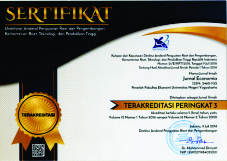Factors Affecting Brand Loyalty among Smartfren Customers
Downloads
Abstract: Factors Affecting Brand Loyalty among Smartfren Customers. The purpose of this study was to analyze the effect of the dimensions of customer value and brand identification on brand loyalty and customer satisfaction as a mediating variable. A purposive sampling technique was adopted to collect 175 Smartfren customers. The results showed that: (1) the functional value has positive effect on customer satisfaction, (2) the emotional value has no effect on customer satisfaction, (3) social values has no effect on customer satisfaction, (4) brand identification has positive impact on customer satisfaction, (5) functional value has no effect on brand loyalty, (6) the emotional value has no effect on brand loyalty, (7) social value has positive effect on brand loyalty, (8) brand identification has no effect on brand loyalty, (9) customer satisfaction has positive effect on loyalty brand, (10) the functional value, emotional value, social value and brand identification simultaneous have no effect on brand loyalty with customer satisfaction as a mediating variable.
Keywords: Customer value, brand identification, customer satisfaction, brand loyalty
Abstrak: Faktor-Faktor Pembentuk Loyalitas Merek pada Pengguna Ponsel Smartfren. Penelitian ini bertujuan menguji pengaruh dimensi dari nilai pelanggan dan identifikasi merek terhadap loyalitas merek dengan kepuasan pelanggan sebagai variabel mediasi. Penelitian ini menggunakan teknik purposive sampling dengan jumlah sampel sebanyak 175 responden pada pelanggan Smartfren. Hasil penelitian menunjukkan bahwa (1) nilai fungsional berpengaruh positif terhadap kepuasan pelanggan, (2) nilai emosional tidak berpengaruh terhadap kepuasan pelanggan, (3) nilai sosial tidak berpengaruh terhadap kepuasan pelanggan, (4) identifikasi merek berpengaruh positif terhadap kepuasan pelanggan, (5) nilai fungsional tidak berpengaruh terhadap loyalitas merek, (6) nilai emosional tidak berpengaruh terhadap loyalitas merek, (7) nilai sosial berpengaruh terhadap loyalitas merek, (8) identifikasi merek tidak berpengaruh terhadap loyalitas merek, (9) kepuasan pelanggan berpengaruh positif terhadap loyalitas merek, (10) nilai fungsional, nilai emosional, nilai sosial dan identifikasi merek tidak terbukti berpengaruh secara simultan terhadap loyalitas merek dengan kepuasan pelanggan sebagai variabel mediasi.
Kata kunci: Nilai pelanggan, identifikasi merek, kepuasan pelanggan, loyalitas merek
Downloads
Bagozzi, R.P., Dholakia, U.M. (2006). "Antecedents and Purchase Consequences of Customer Participation in Small Group Brand Communities". Int. J. Res. Mark. 23 (1), 45–61.
Bhattacharya, C. B., & Sen, S. (2003). "Consumer-Company Identification: a Framework for Understanding Consumers Relationships with Companies". Journal of Marketing. 67(2), 76–88.
Bojanic, D. (1996). "Consumer Perceptions of Price, Value and Satisfaction in the Hotel Industry: an Exploratory Study". Journal of Hospitality and Leisure Marketing 4(1): 5-22.
Butz, H. & Goodstein. (1996). Measuring Customer Value: Gaining the Strategic Advantage. New York: McGraw Hill.
Caruana, A. (2002). "Service loyalty: The Effects of Service Quality and The Mediating Role of Customer Satisfaction". European Journal of Marketing. 37(7–8), 811–828.
Clarke, K. (2001). "What price on loyalty when a brand switch is just a click away?".
Qualitative Market Research: An International Journal. 4(3), 160–168.
De Vries, L., Gensler, S., Leeflang, P.S.H. (2012). "Popularity of Brand Posts on Brand Fan Pages: an Investigating of the Effects of Social Media Marketing". J. Interactive Mark. 26, 83–91.
Deng, Z., Lu, Y., Wei, K. K., & Zhang, J. (2010). "Understanding Customer Satisfaction and Loyalty: an Empirical Study of Mobile Instant Messages in China". International Journal of Information Management. 30(4), 289–300.
Dutton, J.E., Dukerich, J.M., Harquail, C.V. (1994). "Organizational Images and Member Identification". Adm. Sci. Q. 39, 239–263.
Fornell, C. (1996). "The American Customer Satiafaction Index: Nature, Purpose, and Findings". Journal of Marketing 60, 7-18.
Hansen, J. D., Beitelspacher, L. S., & Deitz, G. D. (2013). "Antecedents and Consequences of Consumers Comparative Value Assessments Across the Relationship Life Cycle". Journal of Business Research. 66(4), 473–479.
He, H., Li, Y., & Harris, L. (2012). "Social Identity Perspective on Brand Loyalty". Journal of Business Research. 65(5), 648–657.
Heung, V. C. S., & Ngai, E. W. T. (2008). "The mediating effects of perceived
value and customer satisfaction on customer loyalty in the Chinese restaurant setting". Journal of Quality Assurance in Hospitality & Tourism. 9(2), 85–107.
http://gadget.bisnis.com/read/20140827/280/253021/smartfren-fokus-bidik-segmen-bawah (diakses pada 25 Juli 2016; Pkl. 00.44 WIB)
http://www.smartfren.com/id (diakses pada 3 Februari 2016; Pkl. 07.44 WIB)
https://www.idc.com/getdoc.jsp?containerId=prAP41041116 (diakses pada 3 Februari 2016; Pkl. 07.54 WIB)
Huseni, Umar, 2000. Riset Pemasaran dan Perilaku Konsumen. Jakarta: Erlangga.
Jones, T. O., & Sasser, W. E. (1995). "Why Satisfied Customers Defect?". Harvard Business Review. 73(6), 88–99.
Karjaluoto, H., Jayawardhena, C., Leppaniemi, M., & Pihlstrom, M. (2012). "How Value and Trust Influence Loyalty in Wireless Telecommunications Industry". Telecommunications Policy. 36(8), 636–649.
Kim, H. W., Gupta, S., & Koh, J. (2011). "Investigating the Intention to Purchase Digital Items in Social Networking Communities: A Customer Value Perspective". Information & Management. 48(6), 228–234.
Oliver, R. L. (1999). "Whence Consumer Loyalty?". Journal of Marketing. 63(4), 33–44.
PetrovÄiÄ, A., PetriÄ, G., & Manfreda, K. L. (2016). "The effect of email invitation elements on response rate in a web survey within an online community". Computers in Human Behavior, 56, 320-329.
Schembri, S., Merrilees, B., Kristiansen, S. (2010). "Brand Consumption and Narrative of The Self". Psychol. Mark. 27 (6), 623–637.
Scoot, David Meerman. (2009). The New Rules of Marketing and PR. New Jersey: John Wiley and Sons, Inc.
Stokburger-Sauer, N., Ratneshwar, S., & Sen, S. (2012). "Drivers of Consumer-Brand Identification". International Journal of Research in Marketing. 29(4), 406–418.
Sweeney, J. C., & Soutar, G. N. (2001). "Consumer Perceived Value: The Development of A Multiple Item Scale". Journal of Retailing. 77(2), 203–220.
Tuˇskej, U., Golob, U., & Podnar, K. (2013). "The Role of Consumer-Brand Identification in Building Brand Relationships". Journal of Business Research. 66(1), 53–59.
Wang, S. F. (2011). Development trends of global Internet community. Taipei, TW: The Ministry of Economy ITIS Plan.
Yeh, C.-H., Wang, Y.-S., & Yieh, K. (2016). "Predicting Smartphone Brand Loyalty: Consumer Value and Consumer Brand Identification Perspectives". International Journal of Information Management. 36, 245-257.
Yi, Y., & La, S. (2004). "What influences the relationship between customer satisfaction and repurchase intention? Investigating the effects of adjusted expectations and customer loyalty". Psychology & Marketing. 21(5), 351-374.
Zeithaml, V. A., Berry, L. L., & Parasuraman, A. (1996). "The Behavioral Consequences of Service Quality". Journal of Marketing. 60(2), 31–46.















